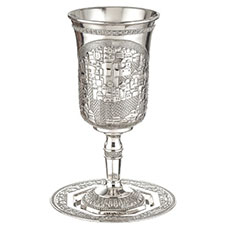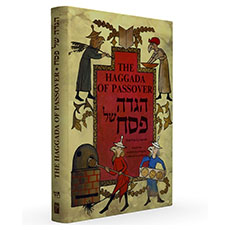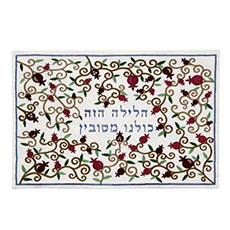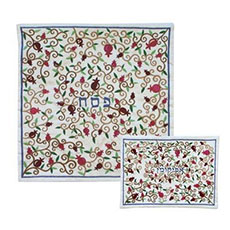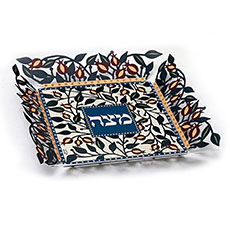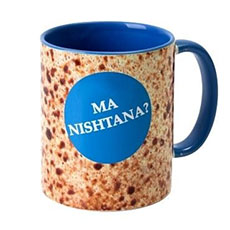Passover, also known by its Hebrew name Pesach, is celebrated every spring. On this holiday we commemorate the deliverance from Egypt and becoming free men after hundreds of years of bondage. We celebrate Passover for seven days, during which there is a strict prohibition against eating leavened bread. The abstinence from leaven is in remembrance of the night when the Hebrews left Egypt so hastily that the bread they baked did not have time to rise. When visiting Judaica stores, some of the Pesach-related items include the Seder plate, Kiddush cup, and the Passover Haggadah, all of which make for great Passover gifts.
The Seder plate is a traditional platter placed in the center of the table. On it are six types of food that evoke ideas related to Passover and the Exodus. Seder plates are so popular that entire Judaica websites are devoted just for the multifarious types that exist.
As of late, stained glass Seder plates are becoming increasingly popular. For the glass-lovers, a great option could be a L16? x W14? greenish-blue glass and pewter plate with Hebrew writings. On outer layer of the plate are six small pewter boards engraved with Hebrew names of the six foods, each to be placed next to its corresponding name. In the middle of the Seder plate is a larger pewter board displaying the Hebrew word, Pesach. While the center of the plate is clear, as you near the rim you can notice the delicate blue and green colors interchanging.
There are many types of Seder plates, including silver, wood, and even gold. Prices of plates range from less than a hundred dollars to over a thousand. If you have many little children at the table it may be a good idea to get a Seder plate that involves childish themes, for instance cartoon Seder plates, animal Seder plates, and more.
The Kiddush cup is used every Shabbos and major holiday. We welcome the special day by performing the Kiddush ceremony and we depart from it by performing the havdalah ceremony, both of which involve reciting a blessing over wine. On Passover, however, the Kiddush cup often plays another important part: Ashkenazis fill the cup, symbolically, for Elijah the Prophet, who is believed to eventually come to announce the arrival of the Messiah. There are countless types of Kiddush cups, or Kiddush goblets, from Sterling silver, to bronze, ceramic and many more. Some cups are etched with images of Jerusalem or traditional Hebrew writings.
The Passover Haggadah consists partly of Midrashim, legends, psalms and prayers that we say on the first night of Passover. The Passover Haggadah is translated into many languages, and many Haggadahs are bilingual, written both in Hebrew and another language. Some Haggadahs are great even for children who cannot read, because they contain vivid, often extremely detailed illustrations. Even adults always enjoy experiencing the Ten Plagues visually illustrated on the page. Because there are so many types of them, Passover Haggadahs are great gifts for all occasions, be it a Bar or Bat Mitzvah, a birthday, an anniversary or any other cause for celebration.
Passover Guide
Passover (or “Pesach”, in Hebrew) is one of the best-known and loved of all Jewish holidays. It is celebrated for seven or eight days (depending on tradition and location inside or outside of Israel). Families gather from all over to celebrate the ritual meal, or “Seder,” children practice reciting the Four Questions, and the delicious aroma of matzah ball soup can be smelled wafting through every home. Rich with tradition, the holiday of Passover has its origins in the Hebrew Bible, and commemorates the Exodus: the liberation of the Israelites from slavery to the Pharaoh in Egypt.
Passover in the Bible
The Biblical book of Exodus tells the story of the slavery of the Israelites in Egypt. After more than 400 years of slavery, G-d heard the cries of the Israelites and sent his messenger Moses to free them. Pharaoh, not anxious to give up his slaves, required some serious convincing, and G-d set Ten Plagues upon Egypt in order to soften Pharaoh’s hard heart. After the tenth and most devastating plague, the death of each firstborn Egyptian male, Pharaoh finally agreed to free the Israelites, and a nation and a holiday were born.
Matzah vs. Chametz
Tradition tells that the Israelites left Egypt in such a hurry (not wanting to give Pharaoh a chance to change his mind) that they did not even take time to allow their bread to rise. As they carried it out of Egypt on their backs, the hot desert sun baked it into flat, hard sheets of unleavened bread. This unleavened bread is today called Matzah, and it is eaten throughout the week of Pesach. Matzah is such an important symbol of Passover that one of the holiday’s names is the “Feast of Unleavened Bread.”
Jewish Law prohibits the eating of any food with leavening (called “Chametz”) during the entire holiday of Pesach, and there are many laws and traditions regarding searching for and ridding the home of Chametz prior to the start of the holiday. Even today, this search is done in a ritual manner, by the light of a candle using a feather and a wooden spoon! These items are often sold in sets to make it easy for everyone to search for Chametz.
The Passover Seder
On the first night (and in many traditions, also on the second night) of Pesach is the Passover Seder. This festive meal contains a carefully prescribed ritual and order (and, in fact, the Hebrew word “Seder” itself means “order.”) During the Seder, the participants hear and participate in the retelling of the story of the Exodus just as if they had been there themselves. A special book called a “Haggadah” (which means “telling”) is used to conduct the Seder, and in it is found the story of the Exodus and a description of all the symbols and rituals that create this memorable night.
A beautifully set table is the centerpiece of the Seder and includes a Seder Plate, especially designed to hold the story’s many symbols--the bitter herb, the green vegetable, the shank bone, a roasted egg, and a delicious mixture of fruits and/or vegetables and nuts, known as “Charoset.” Seder Plates are often beautifully crafted of painted ceramic, porcelain, glass, or even silver.
Some families also grace their Seder tables with specially-designed plates and embroidered covers for holding Matzah. Also prominent on the table is Elijah’s Cup (a cup of wine for the Prophet Elijah) and sometimes a special cup to honor Moses’ sister, Miriam.



